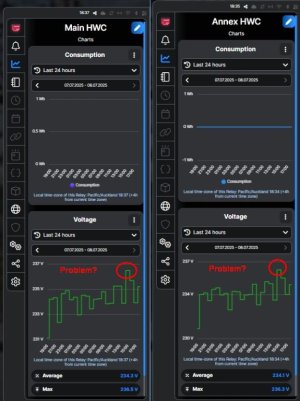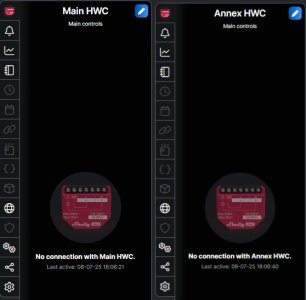Hi
I have 2 Shelly 1PM Gen3's switching on and off Hot Water in the Main and Annex HW Cupboards.
They are on the 2.4GHz Wifi. None of my other 20-odd Shelly's have this issue.
Annex DC A:0C:B1:0A:18
A:0C:B1:0A:18
MainHWC DC A:0C:B1:00:2C
A:0C:B1:00:2C
They keep dropping off the Wifi at (every time) almost the exact same time.
They mostly come back up after 12-15 hours or so, not always after a Router reboot either.
The Router Logs show this:
Forum Check:
Seems a few others have had this with "Ignore" and Bump" and "No Solution" being go-to responses.
I do not use scribe. I do have Traffic Analyzer Statistics turned on.
I am leaning towards me needing RC Snubbers wired to each HWC Switch device (see Voltage Spikes, not sure if that is an issue or not), but if it's a Router Issue that is easier to fix (remotely).
I am on Merlin 3006.102.4 on an RT-AX86U Pro with 3 Mesh Nodes.
Would really appreciate any advice, it is driving us bonkers.
We changed the Shelly's from Shelly 1PM Gen 2 devices to Shelly 1PM Gen 3 a year ago thinking it fixed it, but it's happening again.
Thanks!
I have 2 Shelly 1PM Gen3's switching on and off Hot Water in the Main and Annex HW Cupboards.
They are on the 2.4GHz Wifi. None of my other 20-odd Shelly's have this issue.
Annex DC
MainHWC DC
They keep dropping off the Wifi at (every time) almost the exact same time.
They mostly come back up after 12-15 hours or so, not always after a Router reboot either.
The Router Logs show this:
Code:
Jul 8 18:08:16 kernel: DC:DA:0C:B1:0A:18 not mesh client, can't delete it
Jul 8 18:08:16 kernel: DC:DA:0C:B1:00:2C not mesh client, can't delete it
Jul 8 18:08:27 kernel: DC:DA:0C:B1:0A:18 not mesh client, can't delete it
Jul 8 18:08:27 kernel: DC:DA:0C:B1:00:2C not mesh client, can't delete itForum Check:
Seems a few others have had this with "Ignore" and Bump" and "No Solution" being go-to responses.
- https://www.snbforums.com/threads/not-mesh-client-cant-update-its-ip.73002/
- https://www.snbforums.com/threads/not-mesh-client-cant-delete-it.78274/
- https://www.snbforums.com/threads/s...address-not-mesh-client-cant-delete-it.77909/
- https://www.snbforums.com/threads/asus-rt-ax92u-new-firmware-3-0-0-4-386_45898.75132/
- https://www.snbforums.com/threads/ai-mesh-keeps-dropping.85263/
I do not use scribe. I do have Traffic Analyzer Statistics turned on.
I am leaning towards me needing RC Snubbers wired to each HWC Switch device (see Voltage Spikes, not sure if that is an issue or not), but if it's a Router Issue that is easier to fix (remotely).
I am on Merlin 3006.102.4 on an RT-AX86U Pro with 3 Mesh Nodes.
Would really appreciate any advice, it is driving us bonkers.
We changed the Shelly's from Shelly 1PM Gen 2 devices to Shelly 1PM Gen 3 a year ago thinking it fixed it, but it's happening again.
Thanks!



